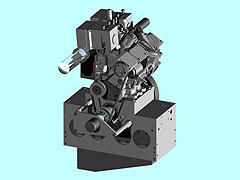Future models - Lotus - ExigeLotus fuels two-stroke and Exige advancesTrim: The Lotus Exige has been given a tweak to sharpen fuel efficiency. Lotus presents Aussie-technology Omnivore research engine and revised Exige10 Mar 2009 LOTUS cars used Geneva to present the latest version of its Omnivore research engine, along with an updated Elise-based Exige S that is expected in Australia later this year. The Omnivore engine concept – displayed as a single-cylinder monoblock – features a new variable compression ratio system and a two-stroke operating cycle with direct fuel injection developed by Australian Orbital. The Orbital FlexDI system, according to Lotus, produces fine in-cylinder fuel preparation irrespective of fuel type, including flex-fuel ethanol. “Together with air pre-mixing, (this) allows efficient two-stroke combustion and low-temperature starting, whilst offering singular opportunity for advanced HCCI control,” Lotus said. Lotus said the two-stroke engine was ideally suited to flex-fuel, as it had a greater amount of optimisation compared with four-strokes. This efficiency stride also increased the range of renewable fuel vehicles. The Omnivore’s monoblock construction combines the cylinder head and block, doing away with a cylinder head gasket for better durability and less mass. Also eliminated are poppet valves, with a novel charge-trapping valve in the exhaust port allowing for the asymmetric timing of exhaust flow and continuous variation of the exhaust opening point.  Left: Lotus Omnivore engine. Left: Lotus Omnivore engine.Lotus said a variable compression ratio was achieved by the use of a puck at the top of the combustion chamber that moved up and down, affecting the change in geometric compression, depending on the engine load. The absence of poppet valves makes the incorporation of a variable compression ratio system relatively straightforward in a two-stroke engine, but difficult in a four-stroke. Group Lotus CEO Mike Kimberley said the automotive sector was focusing on its environmental obligations to improve efficiency, minimise reliance on fossil fuels and reduce harmful emissions. “Lotus continues to be an industry leader through our work on all aspects of future fuels,” he said. “Sustainable alcohol based fuels have the potential to reduce the overall CO2 footprint of internal combustion engines towards zero, and for this reason, need to be embraced as future fuels for road transport.” The Omnivore engine project has several partners, including Queen’s University in Belfast and Orbital Corporation Limited Australia. At last year’s Geneva show Lotus displayed the Exige 270E Tri-fuel concept, which ran mixtures of alcohol-based fuels as well as petrol. This year, Lotus has unveiled a 2010 Exige update with improved aerodynamics for gains in fuel efficiency and carbon dioxide emissions. Cooling to the engine is also revised by a new air-intake system that also works directly on the radiator and twin oil coolers. But while a redesigned rear spoiler also helps reduce wind drag, it still creates 42kg of rear downforce at 160km/h. The changes mean the latest Exige S now drops to 199 g/km of CO2 output, while achieving a European Combined Cycle fuel rating of 8.5L/100km. Read more:Melbourne show: Lotus Evora tops $160KExige pricingMotor industry news |
Click to shareLotus modelsResearch Lotus Exige pricingMotor industry news |














Facebook Twitter Instagram